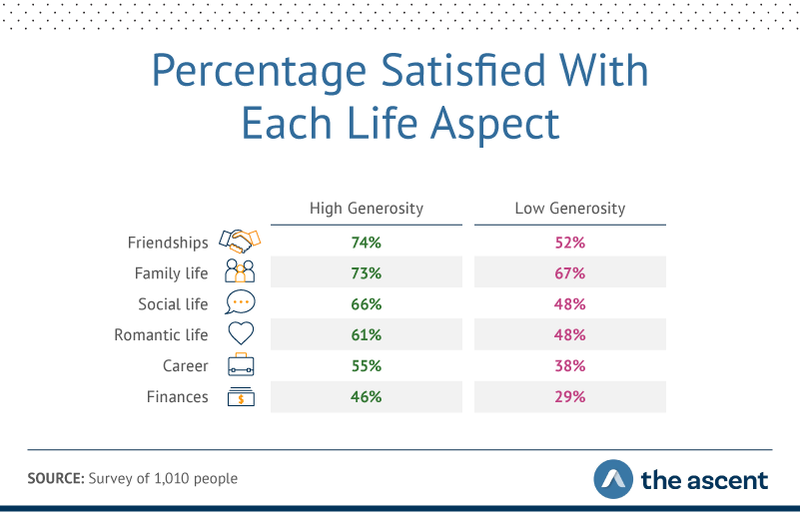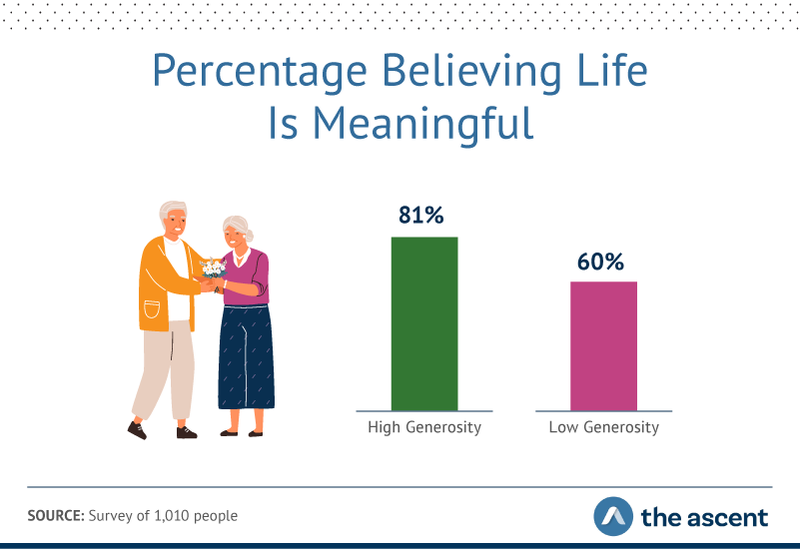
Is giving the key to a happier life? We say yes, but there’s a new study from The Ascent that confirms!
How satisfied are you with your life? It’s probably not a question you think about very often. But it’s an important one.
Here’s another one: Do you want to be more satisfied with your life? A recent study by The Ascent shows how you might be able to do that. Generosity comes in many forms, but no matter how you practice giving, it could be the key to a happier life.
High-generosity people were 23% more likely to be satisfied with their lives overall — but they were also happier with their relationships, their jobs, their possessions, and more.
Let’s dive into the data to see just how much happier generous people are.
Summary of key findings
- More high-generosity respondents reported being satisfied with life and being happy daily than low-generosity respondents.
- People who are more generous are more likely to believe that life is meaningful, be optimistic, and be proud of who they are.
- Generous respondents reported higher scores on the closeness of their relationships, their number of friends, and the number of friends who would help them out of tough situations.
- High-generosity respondents were happier with every factor relating to their jobs and careers.
- Positive measures of mental and physical health were correlated with being generous.
What does it mean to be generous?
We asked over 1,000 Americans about how satisfied they were with various parts of their lives. We also asked them how generous they were. Each participant filled out the Adapted Self-Report Altruism Scale, which asks whether a respondent would engage in 14 different generous behaviors.
Here are a few of the items:
- I would give directions to someone I did not know.
- I would donate clothes or goods to a charity.
- I would voluntarily look after a neighbor’s pet or children without being paid.
Respondents had to say whether they would exhibit those behaviors “never,” “once,” “more than once,” “often,” or “very often.” Each of these responses was assigned a point value (never = 0, once = 1, more than once = 2, and so on).
To determine a respondent’s generosity score, we looked at the total value of all their answers. Those who scored above the 75th percentile were put in the high-generosity group. Those below the 25th percentile were our low-generosity group.
After separating the groups, we took a look at how they answered our questions about satisfaction with their lives. And the responses were very interesting.
Satisfaction through selflessness

High-generosity respondents were more than twice as likely to be “very satisfied” with their life.
They say a candle loses nothing by lighting another candle. When our respondents decided to spread their light through generosity, they actually gained something: 74% of high-generosity people said they were satisfied with their life overall, compared to 60% of low-generosity folks.
And the difference is even more pronounced when looking at people who were “very satisfied” with their life. High-generosity people were more than twice as likely to be in that group.
 When we broke the data down, high-generosity people were more satisfied than low-generosity respondents in every corner of their lives. The former group reported higher rates of satisfaction with their friendships, family connections, careers, and more.
When we broke the data down, high-generosity people were more satisfied than low-generosity respondents in every corner of their lives. The former group reported higher rates of satisfaction with their friendships, family connections, careers, and more.
Finances proved to be the most difficult area for both groups, although low-generosity respondents were significantly less happy. 29% were happy with their monetary situation versus 46% of high-generosity people.

High-generosity respondents were almost three times as likely to be “very happy” every day.
Generous people aren’t just happier overall — they’re also happier more often. 77% of high-generosity respondents reported feeling happy daily, compared to 62% of their low-generosity counterparts (for an average of 72%).
When looking at people who were “very happy” every day, the gap widened. Generous people were almost three times as likely to report being happy every day than less generous people.
Finding meaning in the madness

High-generosity respondents were almost three times as likely to have a “very meaningful” life.
Leading a meaningful life is a lofty goal — but it’s reachable. Especially if you make a point to be generous.
More than 80% of high-generosity respondents felt life was meaningful, compared to 60% who fell into the less-generous category. And when it came to people who said they had a “very meaningful” life, high-generosity people outnumbered low-generosity people by almost three to one.
Written by The Ascent
Image: The Ascent
Publication date: November 9, 2019
MENA’s first free click-to-donate platform – you click, we donate
Learn about about civil society in the Arab World





Copyright © 2024 The Olive Tree SAL, all rights reserved. Terms of Use | Privacy Policy